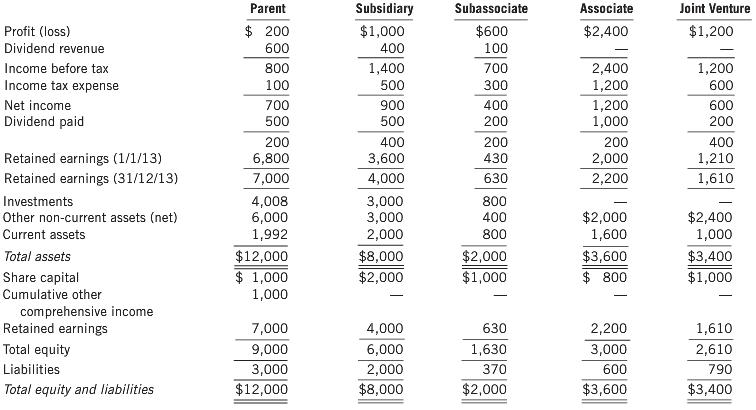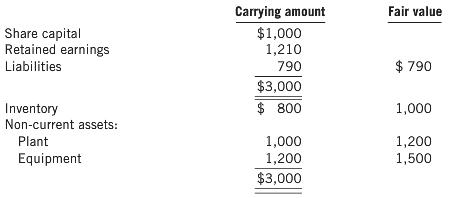Parent has one subsidiary, Subsidiary; one associate, Associate; and one joint venture, Joint Venture. Subsidiary has one
Question:
Parent has one subsidiary, Subsidiary; one associate, Associate; and one joint venture, Joint Venture. Subsidiary has one associate, Sub-associate.

Information about the companies for the year ended December 31, 2013, is as follows:

Additional information:
1. Subsidiary: Parent acquired a 60% interest on December 31, 2005, for $3,000. Shareholders’ equity at December
31, 2005, was:
Share capital …………… $2,000
Retained earnings ………. 2,000
$4,000
At the acquisition date, Subsidiary had not recorded any goodwill. All the identifiable assets and liabilities of Subsidiary were recorded at fair value except the following:

By December 31, 2005, all the inventory had been sold by Subsidiary. The non-current assets had a further expected life of 10 years, with benefits from use being received evenly over these years. The partial goodwill method is used.
2. Sub-associate: Subsidiary acquired, on January 1, 2012, 25% of the share capital for $400. Equity at December 31, 2011, was:
Share capital ………………. $1,000
Retained earnings …………. 230
At December 31, 2011, Sub-associate had not recorded any goodwill. All the identifiable assets and liabilities were recorded at fair value except for the following:

By December 31, 2013, half the inventory had been sold to external parties. The non-current assets have an unlimited life.
3. Parent: Included in current assets of Parent at December 31, 2013, is inventory that was purchased from Subsidiary for $900. Subsidiary sells its goods at cost plus 50% markup.
4. Parent: Included in current assets of Parent at December 31, 2012, was inventory that was purchased from Subsidiary for $600.
5. Subsidiary: Included in the non-current assets of Subsidiary at December 31, 2013, is an item of plant that was sold to Subsidiary by Sub-associate on January 1, 2013, for $1,200. At the date of sale, this asset had a carrying amount to Sub-associate of $1,000. It had an expected future useful life of five years, with benefits being received evenly over these years.
6. Associate: Parent acquired a 25% interest on December 31, 2010, for $400. Equity at December 31, 2010, was:
Share capital …………….. $800
Retained earnings ………… 600
At this date, Associate had not recorded any goodwill. All the identifiable assets and liabilities of Associate were recorded at fair value except for the following assets:

The inventory was all sold by December 31, 2011. The non-current assets had a further useful life of four years.
7. Joint Venture: Parent acquired a 25% interest on January 1, 2012, for $600. A comparison of carrying amounts and fair values at December 31, 2011, is shown below:

The plant had a further five-year life and the equipment had a further six-year life. By December 31, 2013, all the undervalued inventory had been sold.
8. Associate: On January 1, 2011, Associate sold a non-current asset to Parent for $500. At the time of sale, this asset had a carrying amount of $450. Parent depreciated this asset evenly over a five-year period.
9. Joint Venture: At December 31, 2013, Parent held inventory that was sold to it by Joint Venture at a profit before tax of $200 during the previous period.
10. Parent: On December 31, 2013, Parent held inventory that had been sold to it during the previous six months by Associate for $1,000. Associate made $400 profit before tax on the sale.
11. The tax rate is 30%.
Required
In preparation for the consolidated financial statements of Parent for the year ended December 31, 2013:
(a) Calculate the income from Associate, Sub-associate, and Joint Venture.
(b) Calculate the balances in the investments in Associate, Sub-associate, and Joint Venture as at December 31, 2013.
GoodwillGoodwill is an important concept and terminology in accounting which means good reputation. The word goodwill is used at various places in accounting but it is recognized only at the time of a business combination. There are generally two types of... Financial Statements
Financial statements are the standardized formats to present the financial information related to a business or an organization for its users. Financial statements contain the historical information as well as current period’s financial...
Step by Step Answer:






